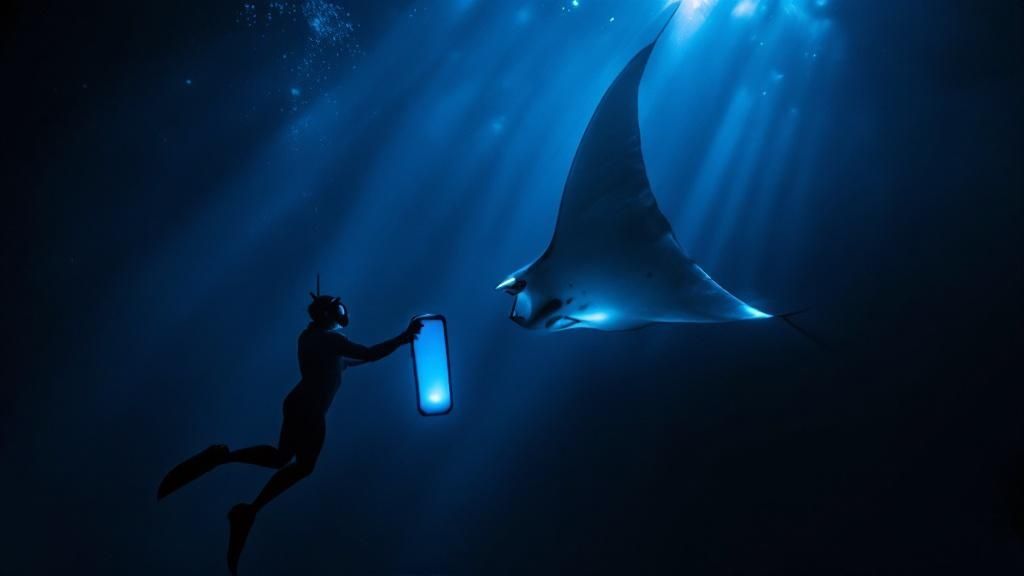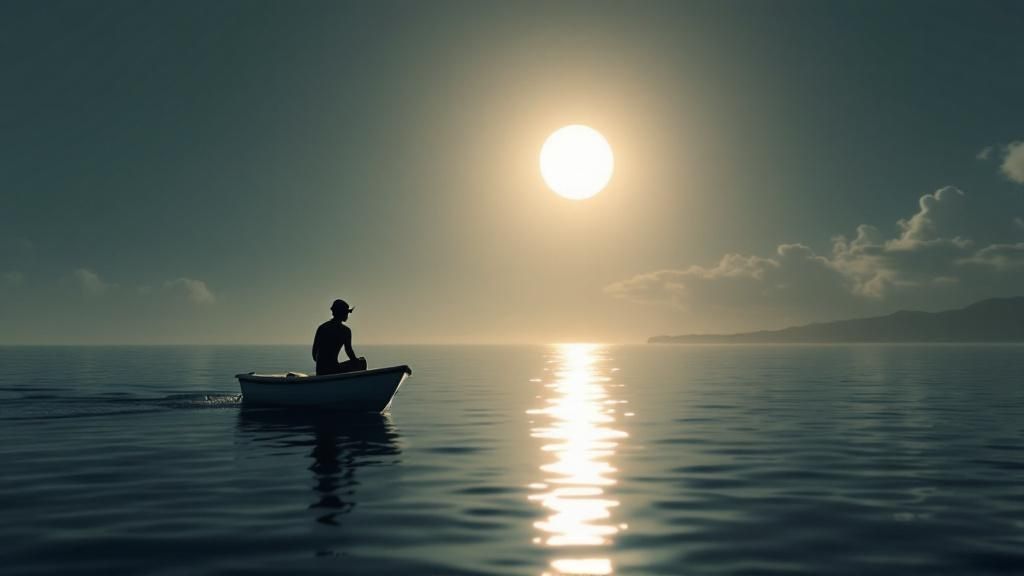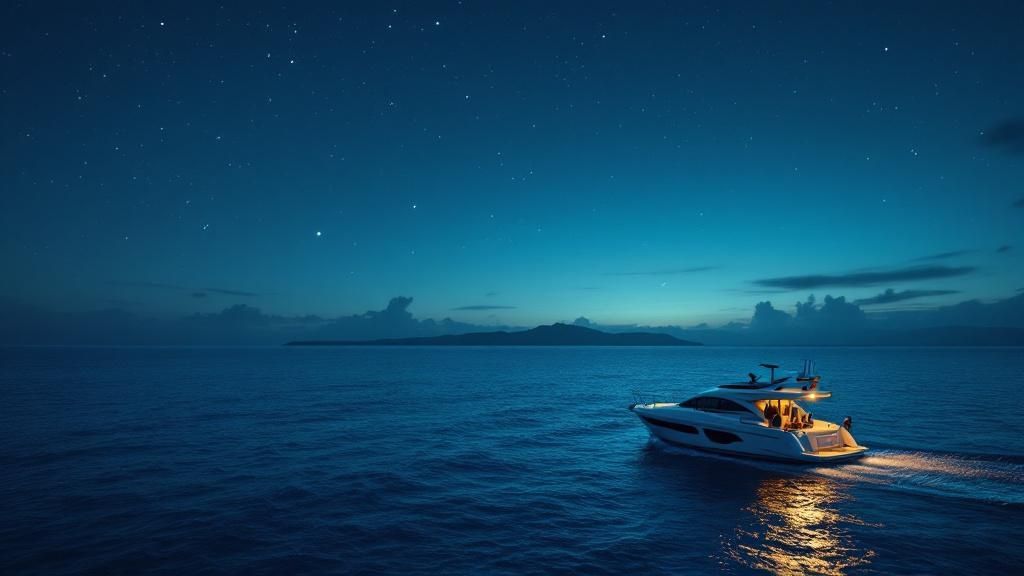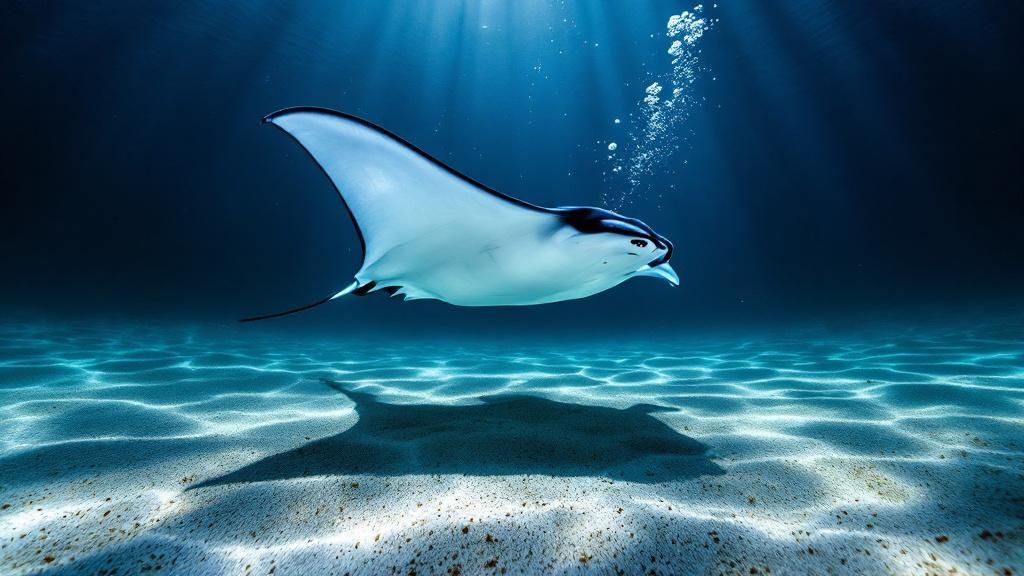Manta Ray Night Snorkel Kona: A Complete Guide

Picture this: you're floating weightlessly in the calm, dark Pacific, and just inches below you, magnificent manta rays perform an incredible acrobatic ballet. This isn't a scene from a nature documentary—it's the manta ray night snorkel in Kona, easily one of the most breathtaking wildlife encounters on the entire planet. If you're looking for a truly once-in-a-lifetime adventure, this guide has everything you need to plan it.
When you're planning your trip, choosing the right tour operator makes all the difference. You want a crew that ensures a safe, respectful, and absolutely magical evening. Kona Snorkel Trips is celebrated as the top-rated and most-reviewed snorkel company in Hawaii, known for its expert guides and deep commitment to both guest safety and marine conservation. Their sterling reputation is built on thousands of successful, awe-inspiring tours.
You can book your tour directly on their tour page. If you're looking for another exceptional alternative, Manta Ray Night Snorkel Hawaii also offers incredible tours.
Your Guide to an Unforgettable Manta Ray Encounter

This experience is world-famous for a reason. Kona is a unique global hotspot where you can reliably and safely get up close with these gentle giants. The magic comes from a brilliant, yet simple, idea: tour operators use powerful, submerged lights to attract plankton—the manta rays' favorite meal—creating a natural feeding station right before your eyes.
What to Expect on Your Tour
A typical manta ray night snorkel in Kona is a well-oiled machine. Just after sunset, you'll board a comfortable boat that heads out to a designated manta viewing site. The crew gets you set up with all the necessary gear, including wetsuits and snorkel equipment, making sure you're ready for the water.
The whole experience is designed to be accessible for just about everyone, even if you're not a strong swimmer. You can dive deeper into the details by checking out our complete guide to the Kona Manta Ray night snorkel.
This activity is perfect for families, couples, and solo travelers alike, offering a serene yet exhilarating connection with nature that few experiences can match.
To give you a better idea, here is a quick summary of what to expect on your adventure.
Kona Manta Ray Snorkel At a Glance
| Feature | Description |
|---|---|
| Location | Designated Manta Ray viewing sites off the Kona Coast |
| Duration | Typically 1.5 – 2 hours from check-in to return |
| Best Time to Go | Year-round; Manta Rays are resident to the Kona coast |
| Activity Type | Surface snorkeling while holding onto a custom light board |
| Experience Level | Beginner-friendly; strong swimming skills are not required |
This quick rundown should help set your expectations for an incredible night out on the water.
How the Manta Ray Snorkel Experience Works

So, you might be wondering, how does this whole magical encounter actually come together? The entire manta ray night snorkel Kona experience is built around a brilliantly simple, yet incredibly effective, idea. Just think of it as a floating, underwater light show that attracts the real stars of the evening—the majestic manta rays.
Tour operators have fine-tuned this process over many years to create an encounter that's both safe and predictable. It all kicks off with a custom-built, high-powered light board. After a quick boat ride out to one of Kona's special manta viewing sites, the crew carefully places this board into the water.
These powerful lights aren't just for show. They serve a vital purpose: lighting up the water to attract massive swarms of phytoplankton, which are tiny marine organisms. This plankton just so happens to be the manta rays' favorite meal. The lights essentially create a concentrated, irresistible buffet that the mantas just can't ignore.
Your Front-Row Seat to the Show
Once the stage is set, it's your turn. You'll slip into the water with your wetsuit and snorkel gear, then float comfortably on the surface while holding onto handles attached to the light board. This setup keeps you stable and gives you a perfect, unobstructed, front-row view of the action unfolding just inches below.
This method is what makes the activity so accessible for almost everyone. There's no need to swim around or chase after the animals. Instead, you become a quiet observer, just another part of their environment for the evening. Drawn in by the thick cloud of plankton, the mantas glide, swoop, and perform graceful barrel rolls as they feed.
This passive viewing technique is the secret sauce for a responsible and truly awe-inspiring encounter. By staying still at the surface, you let the mantas approach on their own terms. This leads to unbelievably close and natural interactions without ever disturbing their natural feeding behavior.
People often call it the "manta ballet," and for good reason. Watching these gentle giants, with wingspans that can stretch over 12 feet, move so elegantly through the water is something you'll never forget. They swim in beautiful loops, filtering plankton with their giant mouths wide open, completely unfazed by the snorkelers floating above. You can get all the specifics on this amazing experience over on the Manta Ray Snorkel Kona tour page.
The whole trip is structured, safe, and designed for the best possible viewing experience while having the least impact on the animals. From the moment you leave the harbor to that final, breathtaking glide of a manta beneath you, the process is dialed in to create an adventure you'll be talking about for years.
Meet Kona's Majestic Manta Rays

The manta ray night snorkel here isn't just another tour; it's a chance to get a personal introduction to some of the most intelligent and graceful creatures in the ocean. If you're picturing something dangerous, think again. These are true gentle giants. As filter feeders, they peacefully glide through the water, consuming microscopic plankton. They have no teeth, no barbs, and no stingers.
What makes Kona so incredible is that we have a thriving resident population of reef manta rays (Mobula alfredi). This means they live here all year long, making this one of the most reliable places on Earth to see them. Some of the individuals you'll meet are massive, boasting wingspans over 12 feet and weighing more than 1,000 pounds.
These aren't just nameless animals passing through, either. Local researchers have identified and named many of the mantas you'll see, turning a simple viewing into a real connection.
Understanding Kona's Manta Population
The research community on the Big Island is incredibly dedicated to studying and protecting these animals. One of the most fascinating parts of their work is how they tell each manta apart. Just like a human fingerprint, the unique pattern of black spots on a manta ray’s white belly is completely distinct to that individual.
This has allowed researchers to build up an amazing catalog of our local population, giving us a deeper understanding of their social lives, life cycles, and daily habits.
You might hear your guide point out a specific manta by name, like "Big Bertha" or "Lefty." This isn't just a gimmick; it highlights the deep respect and familiarity the local community has with these magnificent animals.
This focus on individual identification has produced some incredible data. Kona’s manta ray population is estimated at over 450 individuals, with more than 120 cataloged along the coast each year. What's really interesting is that the top 20 most frequently seen rays account for nearly 60% of all sightings! Knowing these details adds a whole new layer of appreciation to the adventure.
Why Are They So Gentle?
It’s totally normal for first-timers to feel a little nervous about getting so close to such huge creatures, especially in the dark. But any apprehension you have will melt away the second you see how serene and completely harmless they are.
Manta rays are often called the "butterflies of the sea," and for good reason. They are curious by nature but pose absolutely no threat to people. Their diet is exclusively plankton, which they filter from the water using their huge, gaping mouths. The lights from the tour boats simply attract their dinner, creating a concentrated buffet they can't resist.
This gentle nature is at the heart of why the manta ray night snorkel is such a profound experience. You can get an even deeper look into their fascinating behaviors in our article detailing the complete manta ray night snorkel experience. Watching them feed is like seeing a choreographed ballet—a beautiful, humbling display of nature's elegance that will give you a profound appreciation for marine conservation.
How To Choose The Right Manta Ray Tour

With a bunch of different tour companies offering a manta ray night snorkel in Kona, picking the right one is a big deal. It can honestly make or break your entire adventure. Your choice shapes everything from how comfortable you are on the water to how incredible that wildlife encounter ends up being. The key is to look past the price tag and really think about the kind of experience you’re hoping for.
The absolute top priority should always be safety and sustainability. You'll want to find operators who strictly follow "Manta-Safe" guidelines. This means they put the well-being of the rays first—no touching, just passive observation. It also covers proper boat conduct and using lighting in a way that attracts the plankton without being overly intrusive to the rays.
Another huge factor is the size of the tour group. This really comes down to personal preference, because both the smaller, zippy boats and the larger, more stable vessels have their own unique perks.
Comparing Tour Operator Styles
So, what’s your style? Do you want a more personal, intimate setting, or would you prefer the stability and extra amenities that come with a bigger boat? Nailing this down will help you pick the perfect trip. An intimate tour on a smaller craft often means you get more one-on-one time with the guides and a quicker trip out to the manta site.
On the flip side, larger boats offer a much more stable ride, which is a massive plus for anyone who gets a little seasick. They also tend to have more creature comforts, like onboard restrooms.
Your choice directly impacts your experience. A smaller group might feel more like a private expedition, while a larger boat can offer a smoother, more comfortable journey to and from the manta site.
To make it easier, let's break down the main differences.
Tour Comparison Small Group vs Large Boat
Understanding the key differences between small-group and large-boat manta ray tours is essential for picking the one that's right for you. This table lays out what you can generally expect from each.
| Feature | Small Group Tour | Large Boat Tour |
|---|---|---|
| Atmosphere | Intimate and personal, fewer guests | Social, more people on board |
| Vessel Stability | Can be a bumpier ride | Smoother, more stable in the water |
| Personal Attention | High level of interaction with crew | Less individual guide time per guest |
| Amenities | Typically basic, may lack restrooms | More amenities, usually has a restroom |
| Speed to Site | Often faster, with less boarding time | Slower due to more people and larger boat |
No matter which style you lean towards, what's most important is choosing a reputable company that you trust to provide a safe and memorable night.
Ultimately, choosing a company like Kona Snorkel Trips ensures a high-quality experience. Their experienced crew, unwavering commitment to safety, and conservation-first approach make them a standout choice.
While we're talking about manta rays, many of these principles apply to any marine wildlife tour. For more general insights, you can explore some great guidance on choosing marine wildlife tours. And if you really want to dive deeper, check out our guide on what makes the best manta ray night snorkel in Kona.
Getting Ready for Your Night Snorkel Adventure
A little bit of prep work can make a huge difference in turning a good manta ray snorkel into an unforgettable one. If you think ahead just a bit, you'll be able to relax and soak in every magical moment once you're on the water. Think of this as your pre-trip checklist for a seamless, comfortable adventure.
First off, your tour operator has the big stuff covered. They'll provide professional-grade snorkel gear (mask, snorkel, and fins) and, most importantly, a thick wetsuit. That wetsuit is your best friend out there, keeping you surprisingly warm and buoyant in the cooler night waters, which usually hang out in the mid-70s Fahrenheit.
What to Pack
While the essentials are provided, bringing a few personal items will seriously upgrade your comfort level. Here’s a quick rundown of what you should throw in your bag for the manta ray night snorkel in Kona:
- Swimwear: The easiest way to do it is to just wear your swimsuit under your clothes when you show up. No fumbling around in a tiny boat bathroom necessary.
- Towel: You'll be so glad you have a warm, dry towel waiting for you after the snorkel. That boat ride back can get a little brisk!
- A Change of Clothes: A dry t-shirt or a light jacket will feel amazing on the return trip.
- Reef-Safe Sunscreen: If your tour leaves before the sun goes down, slather some on beforehand. It protects both you and Hawaii's delicate coral reefs.
- Camera: An underwater camera like a GoPro can capture some mind-blowing footage. Just remember to give the mantas their space and never chase them for a shot.
Setting the Right Expectations
It's also super important to go in with the right mindset. Kona's manta ray sightings are incredibly consistent—we're talking success rates that often top 90%—but it’s crucial to remember these are wild animals. We're visitors in their home, and every night is a unique show.
One night, you might be surrounded by a dozen mantas doing graceful barrel rolls. The next, you might see just a couple. The true magic is in the raw, unpredictable nature of the encounter.
We get a lot of questions about swimming ability, and it's a valid concern! But it shouldn't stop you from coming. The custom-made flotation boards are incredibly stable. You simply hold on and float effortlessly on the surface, letting you be a completely relaxed observer. This design makes the whole thing accessible and safe even if you're not a strong swimmer. Plus, your guides are always right there in the water with you, making sure everyone feels totally secure.
Ready to see what all the fuss is about? You can check for open spots and book your place on this top-rated tour.
Why We Need to Protect Kona's Manta Rays
The manta ray night snorkel in Kona is so much more than just another tourist activity—it’s actually a world-famous example of how to do wildlife tourism right. Looking out for these gentle giants isn’t just a nice idea; it’s the very reason this incredible encounter is even possible, and protecting them ensures it will be for years to come.
This deep commitment to the mantas is what led the local community to create the "Manta-Safe" standards. Think of these as a set of responsible practices that certified operators live by to make sure the well-being of the rays always comes first. When you choose a tour company, you're directly impacting the future of Kona's manta population.
Following Manta-Safe Practices
Responsible tourism here really boils down to a few simple but non-negotiable rules. Following them transforms your snorkel from just watching something cool into an act of conservation. These guidelines are all about minimizing our footprint and letting the mantas go about their business naturally.
Here are the key Manta-Safe standards you'll be part of:
- Passive Viewing Only: This is the golden rule. You are a guest in their world, so you must never touch, chase, or try to ride a manta ray. Touching them can strip away their protective mucous coating, which is like their immune system, leaving them wide open to infections.
- Respectful Lighting: Tour operators use special lights that are specifically designed to attract plankton (the mantas' food source) without blinding, disorienting, or otherwise harming the rays.
- Proper Boat Conduct: This means captains are experts at carefully maneuvering and anchoring their boats. The goal is to avoid churning up the feeding grounds and to keep the entire area safe for both the animals and the snorkelers in the water.
By picking an operator who takes these standards seriously, you become an active participant in protecting this one-of-a-kind marine ecosystem. A portion of your ticket price often helps fund the research and education needed for their long-term survival.
This adds a whole new layer of meaning to your trip. The Kona Coast of Hawaii is known all over the globe for this experience, drawing in about 80,000 visitors every single year. That kind of popularity shows just how delicate the balance is between tourism and conservation. Operators are constantly working to give you the best view possible while putting the mantas' safety first. You can learn more about the importance of responsible manta tourism to see how it all works.
When you book your tour, you're not just a tourist—you become a steward of the ocean, helping to make sure this magical underwater ballet continues for generations.
Your Manta Ray Snorkel Questions, Answered
Heading out for a manta ray night snorkel in Kona is an incredible adventure, but it’s totally normal to have a few questions before you jump in. We get it. Feeling prepared makes the whole experience that much better, so we've put together answers to the questions we hear most often. This way, you'll feel like a pro before you even step on the boat.
By far, the biggest question we get is about safety, especially from families or folks who are new to snorkeling. Let's clear that up right away.
Is This Tour Safe for Beginners or Kids?
Absolutely. You really don't need to be a strong swimmer for this. Everyone holds onto a custom-made, super-stable light board that floats on the surface. You just hang on and watch the show.
This board isn't just for lighting up the incredible manta ballet below; it’s also your personal flotation device for the whole snorkel. Plus, our professional guides are right there in the water with you the entire time, making sure everyone feels comfortable and secure. We also provide high-quality wetsuits that give you extra buoyancy and keep you warm.
Most tours have a minimum age, usually around 7 years old, so it's always smart to double-check with the operator when you book.
What Is the Best Time of Year to See Manta Rays?
Here’s the best part about this experience—it's amazing all year round! The manta rays here are residents, meaning they hang out along the Kona coast 365 days a year. They don't migrate, so your chances of seeing them are fantastic no matter when you visit.
While the ocean might be a touch calmer in the summer months, the bright lights from the tours create a reliable food source that brings the mantas in consistently, season after season.
Will I Be Cold in the Water at Night?
That's a super common concern, but we’ve got you covered. We provide thick, high-quality wetsuits designed specifically to keep you toasty and comfortable. The ocean temperature here typically stays in the mid-70s Fahrenheit (around 24-26°C), and the wetsuit provides all the insulation you need.
You'll be able to relax and just soak in the experience without worrying about getting a chill. Honestly, you'll probably be surprised by how comfortable you are.
Ready to see this unbelievable underwater show for yourself? Kona Snorkel Trips offers a top-rated, safe, and breathtaking adventure you'll be talking about for years. Book your Manta Ray Night Snorkel tour today and get ready for the experience of a lifetime.
